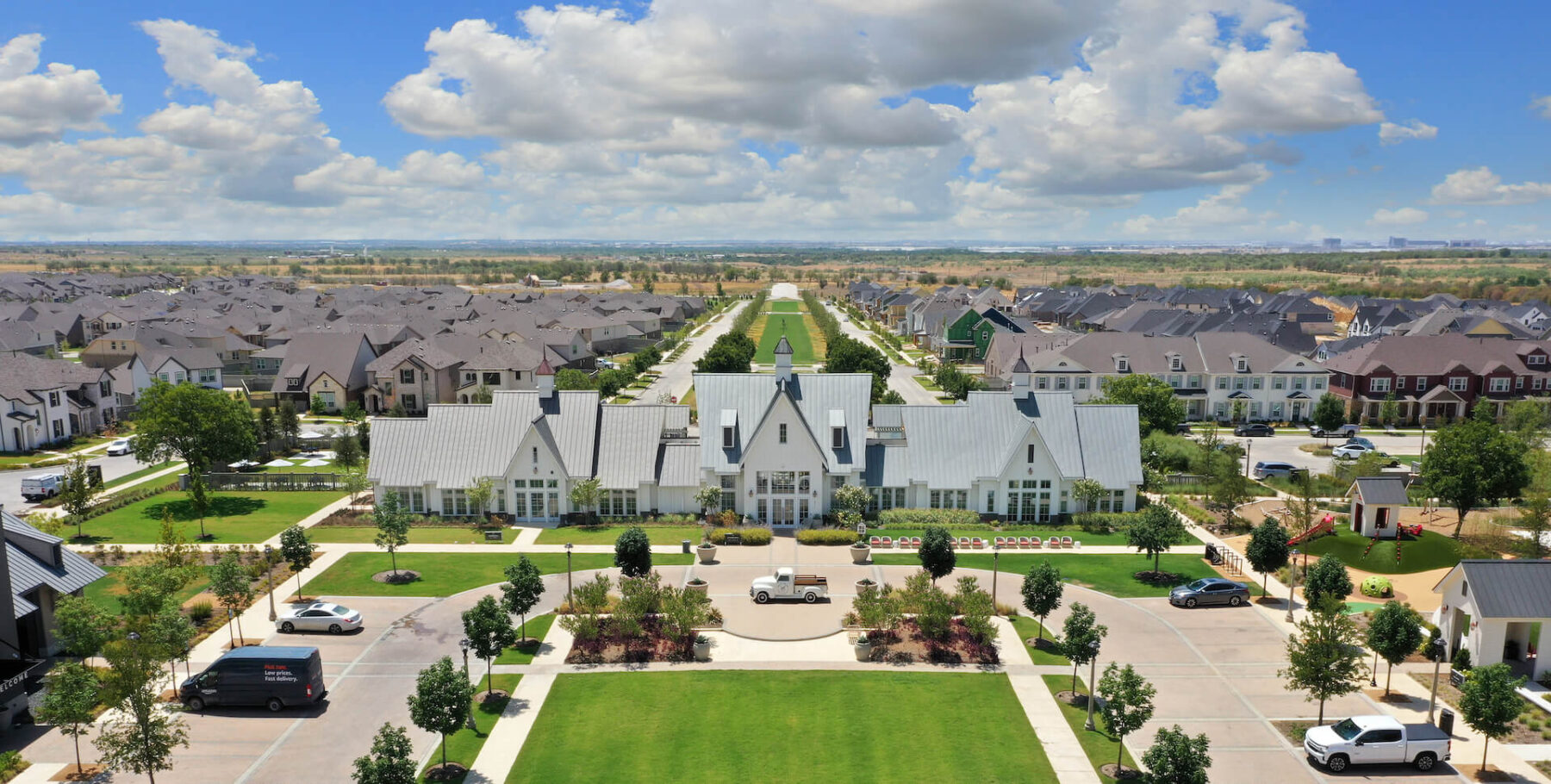

Blog
As one of the most dynamic and rapidly evolving markets in the United States, the Dallas-Fort Worth (DFW) metro area holds a significant place in both the Texas and national economies. As such, it’s often seen as a leading indicator of current housing trends, offering a glimpse into cutting-edge developments as they occur.
That said, the past few years have proven that forecasting anything with certainty in the real estate world can be a difficult task. Fluctuations in interest rates, supply, and demand have all remained volatile, making accurate predictions difficult.
Still, there are plenty of data points that offer indicators of what’s to come in the New Year. In this article, we’ll sift through the multifaceted factors shaping the DFW housing market to provide a clear and comprehensive outlook as we head into 2024.
DFW Housing Market: The Heartbeat of Texas and the Nation
The DFW housing market isn’t just a local reality; it’s also a national narrative. As a hub of economic activity for the Lone Star state and beyond, the DFW area’s real estate trends often reflect broader national shifts and play a pivotal role in shaping housing policies and economic strategies nationwide.
The region saw robust economic expansion in 2023, with continued employment growth and low unemployment, indicating a strong foundation for the housing market. Apartment demand and single-family housing permits increased, although (much like the rest of the country) multifamily permits declined due to tighter credit conditions and higher financing costs.
Key Factors Influencing the DFW Housing Market in 2024
Demographics
- Job Market and Employment Trends: The DFW area’s job market has been very robust, with total nonfarm employment increasing by 139,700 jobs during 2023. This growth took place across a wide variety of sectors, from professional and business services, to financial activities, to mining, logging, construction, and manufacturing. Nineteen corporations relocated their headquarters to North Texas in 2023, bringing thousands of jobs now with more projected in the coming years. The diversity of industries seeing growth in DFW points to a strong and multifaceted economy that is likely to continue attracting new residents and businesses through 2024.
- Population Growth and Age Trends: While the state of Texas has seen six of its cities among the nine fastest-growing cities in the South, the DFW metroplex has experienced the most significant population boom. Between 2021 and 2022 it had the highest increase in the population of any U.S. metro area, with 170k+ new residents and there are no signs this growth has slowed. These figures suggest a dynamic and expanding demographic landscape in the DFW area, a major influence on its real estate landscape.
- In-migration from Other States and Countries: The population growth across the DFW metroplex is fueled by significant in-migration from other states and countries. This influx is driven by the area’s economic opportunities, cultural amenities, and overall quality of life. The Dallas-Fort Worth area’s capacity to attract a diverse population contributes to its dynamism and resilience as an economic hub.
Economy
- Interest Rates and Mortgage Affordability: In 2023, the Federal Reserve continued its string of interest rate hikes, which subsequently impacted the housing market. Increased rates meant higher mortgages, which significantly affected affordability. Mortgage rates rose from about 3% to as high as nearly 8%, causing a slowdown in housing activity. But as the Fed halts further rate hikes in 2024, falling mortgage rates could turn the trend of decreasing home sales around.
- Inflation and Construction Costs: Inflation is also impacting the cost of construction and housing materials, which can affect housing affordability and the pace of new construction. The combination of high mortgage rates and inflation poses a challenge to the new housing market in the DFW area.
- Overall Economic Growth: Despite these challenges, the DFW area’s strong population and job growth are expected to support the still-booming regional economy. The region’s economic expansion and employment growth have been outpacing national averages, suggesting a relatively resilient local economy.
Housing Supply
- Current Levels of Inventory and New Construction: In terms of housing supply, there has been a steady increase in single-family permit issuance since spring 2023, although the year-to-date issuance as of August was down compared to the previous year. This indicates a cautious but ongoing growth in new home construction.
- Impact of Zoning Regulations and Development Costs: Zoning regulations and development costs are critical factors that can influence the supply of new homes. High construction and financing costs, as well as regulatory barriers, can limit the pace and scale of new housing developments.
- Availability of Land for Development: Another crucial factor affecting housing supply is the availability of empty land for new home development. The DFW area, being one of the busiest large U.S. metros in new construction, could face challenges ahead when it comes to finding suitable and affordable land for further development, especially as the population continues to grow.
Housing Demand
- First-time Homebuyer Trends and Preferences: In 2023, half of all homebuyers were purchasing their first home, marking a significant increase from previous years. The surge in first-time buyers is partly due to existing homeowners choosing not to sell or buy new homes, as many are locked into mortgage rates that sit well below current levels. The rise in mortgage rates has impacted first-time buyers significantly, drastically reducing their purchasing power. For instance, a buyer with a budget of $3,000 a month could afford a $429,000 home at a 7.4% mortgage rate, a notable decrease from what could have been afforded at lower rates even a year ago.
- Demand from Millennials and Other Age Groups: Millennials and other younger demographics are increasingly feeling the pressure of high housing costs. Many in this age group believe the government hasn’t done enough to make housing affordable, as evidenced by a recent study. The gap between home prices and consumer income has widened significantly, with the income required for a typical first-time buyer rising from about $70,000 in 2019 to $90,000 just three years later in 2022.
- Impact of Remote Work on Housing Choices: It’s no surprise that the rise in remote work has dramatically influenced the housing preferences of new home buyers. With the need for proximity to workplaces reduced, many remote workers are opting for homes in suburbs and rural areas, seeking larger living spaces, access to nature, and a lower cost of living. This shift is driving demand in these areas and is reflected in the types of homes being purchased and their locations.
Government Policies
- Federal Housing Policies: In 2023, the Federal Housing Finance Agency (FHFA) announced updates to Fannie Mae and Freddie Mac’s Equitable Housing Finance Plans. These updates aim to provide equitable access to affordable and sustainable housing, including actions to remove barriers for Latino renters and homeowners, support for locally-owned modular construction in communities of color, and the inclusion of rental payments and cash flow in automated underwriting systems. These initiatives are part of a broader strategy to promote fairness and accessibility across the entire housing market.
- State and Local Policies in Texas: The Texas legislature has introduced several new bills to try and address the housing affordability crisis by speeding up the construction of new homes and apartments. The proposals include allowing builders to use less land for single-family homes, easing city housing regulations, and creating a state housing tax credit to supplement the federal program. Additionally, there are proposals to set up a state fund to finance housing for middle-income workers like teachers and healthcare workers.
Predicting the DFW Housing Market in 2024: a Brighter Outlook Ahead
Entering 2024, the Dallas-Fort Worth housing market appears poised for nuanced changes. Key factors influencing this market include robust population growth, a thriving job market across a variety of diverse industry sectors, and the ongoing impact of remote work on housing preferences. However, challenges such as rising interest rates, inflation, housing supply and affordability persist, affecting both demand and supply.
For homeowners, new homebuyers, and investors navigating the DFW housing market in 2024, a strategic and informed approach is crucial. The metroplex area remains a popular destination, and thus a competitive one when it comes to buying a home. Homebuyers should be aware of the higher income requirements for purchasing homes in Dallas proper, with the median sale prices sitting at around $275,000 in 2023. Exploring surrounding suburban areas where the income necessary to afford a home is relatively lower, might offer more opportunities.
Remote work’s continued influence suggests a preference for affordable new homes that can accommodate home offices and offer a high quality of life. Dallas Fort Worth has proven to be an incredibly attractive destination for remote workers and could see sustained demand in housing developments that cater to this particular demographic.
While the outlook for 2024 is optimistic, potential homebuyers and investors should be aware that unforeseen events (e.g. natural disasters or geopolitical instability) could disrupt the housing market unexpectedly. Staying informed, flexible, and prepared will be key to successfully navigating the DFW housing market in the coming year. We always recommend consulting with a trusted Realtor throughout the homebuying process.
DFW Housing Market Forecast 2024: FAQ’s
Will Dallas home prices drop?
While predicting exact price movements is challenging, the Dallas housing market is showing signs of moderation. Prices may not significantly drop but could stabilize or increase at a much slower rate in 2024.
Are Texas home prices going down?
As of 2024, Texas home prices have experienced a slight decrease from recent highs, but not a steep drop. This trend is primarily driven by higher mortgage rates, exerting downward pressure on home sales and leading to a 5.9 percent year-over-year decline.
And while home prices are projected to fluctuate statewide depending on the region (for example, the DFW area saw sharp declines in new home pricing during 2023), the overall market remains strong. Instead of bottoming out, overall home prices are expected to rise slightly by the end of 2024.
What is the housing market forecast for Dallas in 2024?
Markets like Austin, Dallas-Fort Worth, and Houston remain hot, driven by strong job growth, population influx, and a relatively affordable cost of living compared to other major U.S. cities.
What are the hottest real estate markets in Texas?
Markets like Austin, Dallas-Fort Worth, and Houston remain hot, driven by strong job growth, population influx, and a relatively affordable cost of living compared to other major U.S. cities.
Is Texas in a buyer’s or seller’s market?
While it has been a seller’s market in recent years, Texas is currently moving towards a more balanced market. 2024 may see conditions that are much more favorable to buyers, such as increased inventory and slower price growth.
Explore Your DFW Homebuying Options in a Hillwood Community
If you’re considering a new home in Dallas-Fort Worth, Hillwood Communities offers a range of lifestyle communities. It’s an ideal time to find a new home in the thriving DFW metro area, with many builders offering attractive incentives! We encourage you to tour our communities, visit the builders’ model homes, or contact us directly for more details.

